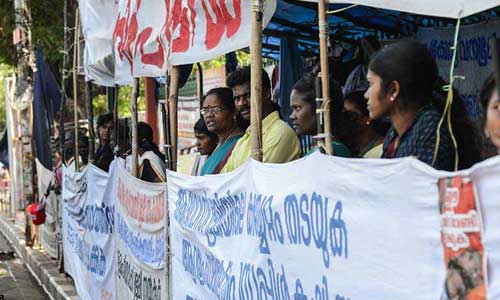By Shafeeq Hudawi, TwoCircles.net,
Thiruvananthapuram: On Wednesday, when Kerala observed the World Human Rights Day with rallies, seminars and talks, a vulnerable section – adivasis, hailing from various tribal settlement – were left out of celebrations.
Fighting for a piece of land that belongs to them, these adivasis (tribals) were standing in front of the Secretariat, for four months in a row.

The standing struggle by Kerala’s indigenous people – organized by the Adivasi Gothra Maha Sabha – testifies how a democratic society ignores the battling of the tribal community for the survival. It also shows the strong emotion of the adivasis of Muthanga, Aralam and Attappadi and their demand as they have legal right to get the land they have been fighting for.
“We are not demanding anything new. The promise that the state government gave in 2001 and the rehabilitation measures announced by the government after the Muthanga incident of 2003 should be implemented. The tribal community has no access to the benefits of the state’s human development while the other residents enjoy all. They are still fighting for basic rights, including ownership of land,” says C K Janu, the chairperson of Adivasi Gothra Mahasabha.
As per the Antony- C K Janu pact signed in 2003, the government is obliged to distribute up to five acres of land for the adivasi families following the Muthanga agitations, which were later called the mile stone in the history of adivasis in the state.
In 2003, the adivasis had gathered under the Adivasi Gothra Maha Sabha protesting the delay in allotting them land, which had been contracted in October 2001 in Muthanga of Wayanad district. These tribals had launched a land redistribution agitation in Muthanga. They put up over 700 huts and established a check post to regulate entry. These landless people were all set to settle down on land that had been allocated to them, after several decades of attempted procurement through institutional avenues had failed. Besides the encroachment of the farmers, through the establishment of ‘reserved forests’ the government had banned them from entering their land.
As part of the agitation adivasis took captive 21 persons, mostly state policemen and forest department officials. The next day, the adivasis handed over the captives unharmed to the Wayanad district collector, putting their statements on record, and were given assurances that there would no further attempts at eviction.
On the morning of February 19 that year, around 1000 heavily armed police and forestry officials moved in to the tribal colonies in Wayanad setting on fire their huts. During the operation, 18 shots were reportedly fired leaving four adivasis and a police man dead and several others seriously injured. Prominent leaders of AGMS including C K Janu and Geethanandhan were arrested.
Taking a cue from the agitation and shocked by the repeated death of adivasis reported in Attappady and Aralam, on October 14, 2001, AGMS activists led by C K Janu and Geethananthan started to set up huts in front of the important offices in Thiruvananthapuram. The adivasis across the state started to flow to the state headquarters to participate in the strike. The support of the public, media and opposition front pressed the government to take stringent action.
After days of strike, the state government agreed to address the woes faced by the poor tribal community. The two sides reached an agreement in principle that landless persons, or those owning less than an acre, will be disbursed up to five acres of land within one year in a pact signed between AGMS chairperson C K Janu and Chief Minister Oommen Chandy.
Though the government launched the much celebrated land distribution scheme, it sputtered out with disappointing results for the adivasis. Their leaders point out that the scheme was sabotaged in its very early stage owing to influence of the vested interests groups, who controlled the forest and plantation-based economy.
Reminding the intention of the standing struggle convener, Geethananthan said that the scheme was an utter failure as majority of the adivasis are still struggling to live.
“The government has been indifferent to their basic demands like the implementation of the ‘Adivasi Grama Sabha’ and agricultural projects in Attappadi, where the rate of malnourishment and infant mortality is high,” he added.
They accuse the tribesmen Maoists while they demand for their rights and launch protests against the denial of justice. But, the government forgets to keep its word given by the Chief Minister A K Antony to evacuate the encroachers from their land and give them back as a mean of surviving, said C K Janu.

“Farmer have encroached 3000 acre pineapple farm leaving the adivasis landless at Aralam in Kannur. The case is same in the tribal settlements in Wayanad, Attappady and Idukki,” she said.
“We have had discussions with the Chief Minister for two times and once with P K Jayalakshmi, the Minister for Tribal Welfare. Our demands have been partly accounted, but they were reluctant to give a written assurance. We want a written assurance for our demands after a Cabinet meeting,” said Geethanandan.
“While it comes to ensuring the rights for adivasis, the state has been violating constitutional provisions. The government has violated High Court orders regarding the upholding of the constitutional rights of adivasis,” he said.
Meanwhile, Minister for Tribal welfare P K Jayalakshi said in a media release that the protest has helped the department to fasten the developmental works for adivasis. She added that there was a flow of opposition from all tribal organisations, other than Gothra Maha Sabha for implementing Adivasi Grama Sabha rules without much thought and deliberation.
But P K Jayalakshmi has not even visited the protest ground and this has annoyed the adivasis the most.
The only thing positive for the adivasis is the support extended by social media and campuses and a hope they might help in changing the present scenario.

